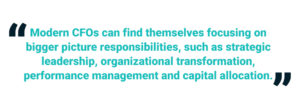5 Questions Every CFO Should Expect from the CEO
The world of technology is changing. And no position is immune to the changes, including CFOs. In fact, a McKinsey & Company Survey shows that CFOs spend about 40 percent of their time outside of traditional CFO activities. But what are these new activities?
This depends on the organization, but there some commonalities. Modern CFOs can find themselves focusing on bigger picture responsibilities, such as strategic leadership, organizational transformation, performance management and capital allocation. Likewise, CFOs can be heavily involved in big data and analytics, as well as finance capabilities. Technology trends, including digitizing business activities and planning cybersecurity tactics, take up a new portion of CFO time.
So, as the job changes and the CFO becomes a bigger piece of the company’s goal-making, CFOs can expect the demands of the CEO to shift. Recently, a Sage Intacct webinar illuminated some of the top questions CFOs are being asked.
Question 1: Where are we on hitting company long-range goals?
As a CFO, you have a slew of goals. One of the most easily dismissed is the long-term goal, typically the three to five-year plan. The reason is that annual budgetary goals have a tendency to demand elbow room.
Probably the most difficult task is getting senior management to buy into a long-range goal. Depending on the size of the company, reaching consensus has a varying level of struggle. But once everyone is on board, it’s important to check back into your long-range goal every quarter or so to make sure you aren’t pushing your total years of accomplishment out.
In your position, you want to make sure you have the right metrics in advance. When you see a change in these quarterly reviews of long-term goals, you have to know why something changed, both positively and negatively. Accurate and timely reporting of financial data is critical. Things can shift dramatically and quickly. Tracking your goal, therefore, is essential.
Question 2: What are the investment opportunities you’re considering and how do they compare?
Due diligence is difficult. Human nature wants you to paint a picture that fits the opinion you already have. This is especially true when planning investment opportunities. Ultimately though, you have to answer to not only the CEO but also the board and the shareholders.
With this in mind, developing a roadmap for investments must be strategic. When planning investments, you want a strong ROI matrix detailing (particularly to those without a finance background) how the end result is worth the effort. Most companies don’t have the luxury of a Steve Jobs level of flippancy when it comes to new products, for instance. Apple can (could under Jobs) just build something and see if customers will come to it. The rest of us must build success metrics around customer growth and long-term gains. This will change based on the entrepreneurial spirit of your CEO: Underfunding, as we all know, is the death of many great ideas.
Question 3: Where are we on cash and sources of funds?
For many CEOs, avoiding or paying off debt is the highest priority. This becomes an important metric for CFOs who are reconciling bank accounts with cash on hand. Are you losing money as a business or generating profit as a business? Cash flow forecasting can give you a better grip on how your company can navigate the near and long-term future.
When forecasting cash flow, your CEO wants to know that you’re doing something smart with the money on hand. If you’ve raised a couple hundred thousand, for example, you may not need all that money right now. Your investments can make a huge difference in your P&L sheets.
Question 4: How should we measure results impacting the business?
What’s driving your revenue? What’s driving expenses? Measuring results requires a strategic lense. Do you measure by season or year over year?
CFOs constantly look for non-financial measures to have financial results. Because that’s how a business functions and that’s how CEOs think. So, you do yourself a favor by thinking somewhat alternatively to non-financial metrics. For instance, how do repeat customers affect your financial data? If you have multiple locations, does square footage have a financial impact?
By using alternative thinking, you start to separate the obvious from the non-obvious. This will keep your target audience engaged – your CEO, board, shareholders and others without financial backgrounds. Your detailed understanding of what works and what doesn’t, and why, means you are armed with solutions
Question 5: In terms of business risk, what questions do we not have answers for?
Business risk is a little like backup and recovery planning. As part of your planning, you need to consider risk scenarios to determine how your business will react to new threats. Say a new competitor comes into the market, or the market itself changes, you need a course of action to help you navigate troubled waters so you can survive economic downturns. Armed with likelihood and remediation options, you set yourself up for greater success metrics.
Finally…
There is a distinct relationship component between CEOs and CFOs. The key is to cut through the financial jargon and get down to brass tacks. As CFOs are expected to play a greater role in strategic thinking, you need data-driven insights to help your CEO drive better decisions.
With the influx of complex financial software, we are seeing CFOs get closer and closer to real-time data analytics. Alta Vista’s Sage Intacct offering is helping reinvigorate data analytics and the modern CFO.
Call us to find out how automation can transform the way you collect data.













